Introduction: In this article, Jessica Edwards gives tips for finding and using passenger lists in your genealogy research, and provides many helpful links. Jessica has had a lifelong interest in her family’s history – especially on her father’s side, which goes back to the first settlers in Pennsylvania, Jamestown and New England.
When I taught genealogy classes, two of the most common questions I was asked were:
- What are passenger lists?
- How can they help a genealogist?
In this article, I have put together some brief “how-to’s” about passenger lists, what information can be found in them, and provided some useful links.

What Are Passenger Lists?
From the 1600s through the early 1900s, most immigrants entered the U.S. by ships. Sometimes, they were counted before they left the port to start their journey – and, if they survived the passage, they were counted again when they landed in America, with their names entered on a ship’s passenger list. These passenger lists contain vital information for ancestor detectives and can include such things as the immigrant’s name, age, marital status, occupation, and nationality.
Most passenger lists have information that will be found on more than one page (recently I stumbled onto this fact when I noticed that a second page to each log had the names and information of what family members they were going to live with, and what town they were going to live in), so read carefully. Some of the other things you can learn from a ship manifest can include: where they sailed from; their last residence; a contact in their country of origin and their relationship; their final destination; how many bags they had; the ship’s name; and how much money they had with them.
Ports of Entry
Contrary to popular belief, not everyone came through Ellis Island. There were many ports of entry all across the U.S. The main ports were New York, Boston, Baltimore, Philadelphia, and New Orleans, but other places ships arrived were: Portland, Maine; Seattle, Washington; Charlestown, South Carolina; San Francisco, California; Savannah, Georgia; Mobile, Alabama; Providence, Rhode Island; Alexandria, Virginia; and many other smaller ports along the coasts – so don’t ignore the other ports.

What Is Ellis Island?
Ellis Island, now a 27.5-acre site located just minutes off the southern tip of Manhattan Island, New York, is likely to connect with more of the American population than any other spot in the country. It has been estimated that nearly half of all Americans today can trace their family history to at least one person who passed through the Port of New York at Ellis Island. The record for the year with the most immigration was 1907 (1,285,000 people).
Now, more than a century after the peak years of immigration, Ellis Island is one of the most popular tourist destinations in the National Park Service.
The Ellis Island Foundation maintains a free Ellis Island Passenger Search database, home to 65 million records of passengers arriving to the Port of New York from 1820 to 1957.
GenealogyBank
The arrival of passengers was big news, and newspapers published passenger lists to inform their readers. There are thousands of passenger lists in GenealogyBank’s collection of more than 13,000 newspapers, and even a special Passenger Lists search form to help with your family history research.
Some Interesting Sites That Relate to Passenger Lists
Check out these sites:
- https://www.archives.gov/nyc (microfilm of indexes to passenger lists of vessels arriving at the Port of New York for the years 1820-1846 and 1897-1943)
- https://www.familysearch.org/ (records and indexes from the 1600s to 1960s)
- https://www.gjenvick.com/ (ship passenger lists – USA, Canada, Australia, and other world ports, from the 1870s to the 1960s)
- https://www.germanroots.com/ (list of indexes of passenger list ships that sailed to the United States from 1820 to the 1950s)
- https://members.tripod.com/~Data_Mate/irish/Irish.htm (transcribed ship records for Irish immigrants in the 1800s)
- https://www.olivetreegenealogy.com/ (is a little hard to navigate but has passenger list resources broken down into various year ranges, back to the 1600s)
- theshipslist.com
- https://www.statueofliberty.org/ (database of people who came through Ellis Island)
- https://www.sec.state.ma.us/ (passenger manifests 1848-1891; the entries do give their name, age, occupation, arrival date, and other key facts)
- https://www.mainegenealogy.net/ (Maine passenger lists 1820-1867; database of arrivals from 1820-1867 for several ports)
- https://archive.org/details/vesselpassengerlists (passenger lists of vessels for Baltimore and Philadelphia covering 1800 to the mid-1940s; they also have passenger and crew lists for ships arriving in New York from 1897-1957 )
- https://digitalcollections.hawaii.gov/ (searchable databases for Chinese, Japanese, and Portuguese passenger lists)
Books
Here are some books that may be helpful (these are just a few, as many, many more can be found at your local public or genealogical libraries or on sites that sell books):
- Emigrants to Pennsylvania, a Consolidation of Ship Passenger Lists from the Pennsylvania Magazine of History and Biography by Michael Tepper
- German Immigrants: Lists of Passengers Bound from Bremen to New York, 1847-1854, with Places of Origin by Gary J. Zimmerman
- Irish Passenger Lists, 1847-1871. Lists of Passengers Sailing from Londonderry to America on Ships of the J. & J. Cooke Line and the McCorkell Line by Brian Mitchell
- Ship Passenger Lists, Pennsylvania and Delaware (1641-1825) by Carl Boyer
- Ship Passenger Lists, The South (1538-1825) by Carl Boyer
- Ship Passenger Lists, National and New England: 1600-1825 by Carl Boyer
- They Came in Ships: Finding Your Immigrant Ancestor’s Arrival Record by John P. Colletta
Explore over 330 years of newspapers and historical records in GenealogyBank. Discover your family story! Start a 7-Day Free Trial
